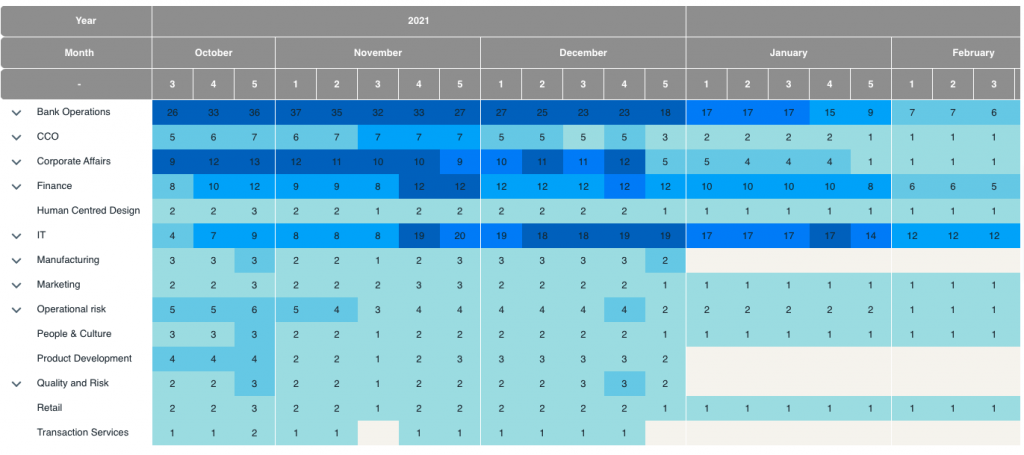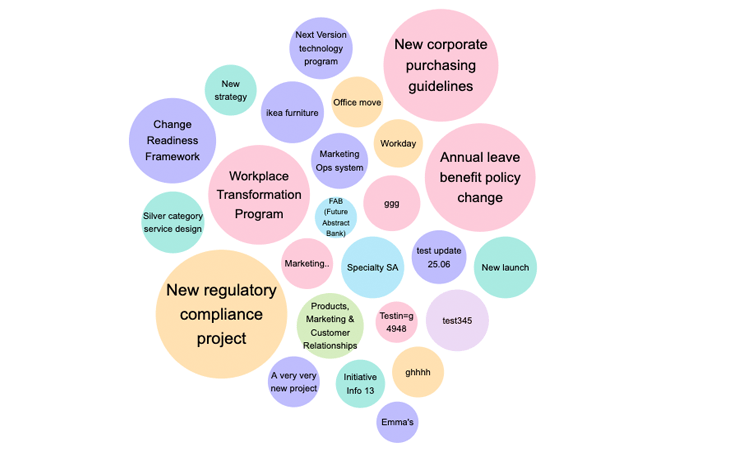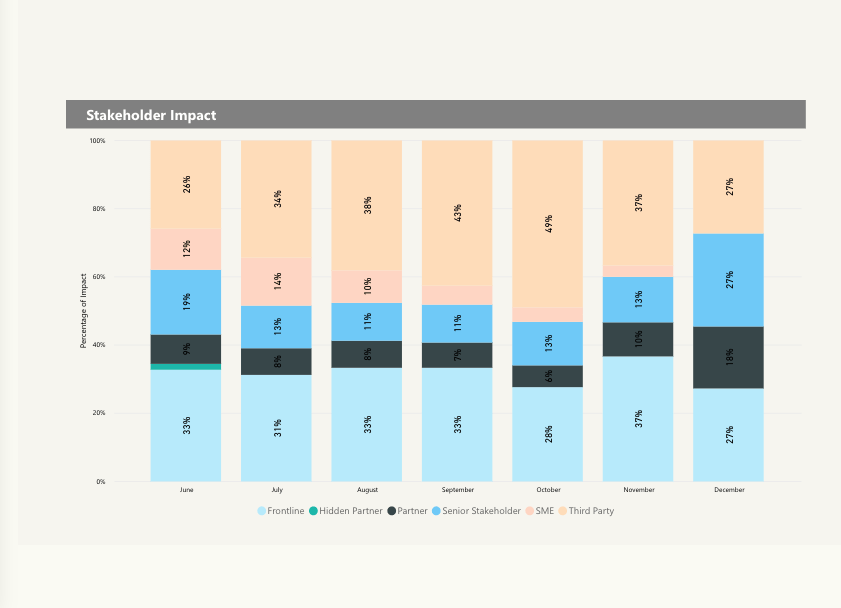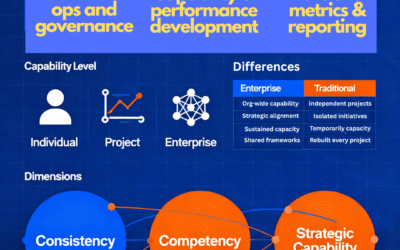The change management profession has grown by leaps and bounds. This is proportional to the speed and magnitude of change that organizations are currently going through. To manage this complexity, a lot of large organizations have created ‘enterprise change management’ or ‘portfolio change management roles’ to tackle this.
In the same way that there are portfolio managers to manage a suite of projects, organizations are realizing that portfolio change managers may be needed to effectively drive change success. Like the portfolio manager, the portfolio change manager also manages a particular group of initiatives. This grouping is usually done based on the size of change initiatives and or business groups. There are also examples of groupings by ‘value stream’ or program clusters. For example, a portfolio change manager may be in charge of all technology projects and supporting the technology group, whilst another portfolio change manager support sales and marketing initiatives or back office groups.
To download our infographic on how to manage a change portfolio click here.
As a new field, there is not a lot of ‘how-do’ guides for the new portfolio change manager. A quick scan of the internet found very little substance in term of all facets of the work of the portfolio change manager. This guide is written to fill this gap and to help those starting out in this role or decisions makers considering creating such roles to build change effectiveness.
To effectively manage the change initiatives within the portfolio, the change portfolio manager needs to proactively work on the below 7 key areas:

Marketing group working on presentation. Scrum meeting, teamwork, task list. Business concept. Vector illustration can be used for presentation slides, landing pages, and posters
1) Service offering
Defining the service you are offering to the organization is one of the most critical activities. To do this, you need to conduct an assessment of where the organization is at and its various needs for change management services. Key questions to ask include:
- How mature is the organization in managing change? You may want to refer to the Change Management Institute’s model of Change Maturity here to understand the different stages of organizational change maturity
- How much change is the organization going through? This will help determine the capacity of services required
- How much investment is the organization willing to make to support change management? There may be a budget already set or you may need to make a recommendation based on any available internal or external benchmarks
- What are the most critical needs? Conduct stakeholder interviews or workshops with senior managers, middle managers and frontline groups to understand current change challenges holistically.
After understanding the needs of the organizations and where the organization would like to head to in its change management objectives, one can then define services required.
Common services offered by a portfolio change manager or portfolio change management function includes:
- Change project delivery services (e.g. change impact assessment, change planning, stakeholder management, etc.)
- Change diagnostics (e.g. initiative change health assessment)
- Change capability improvement offerings (e.g. training, workshop facilitation, leadership assessments)
- Coaching and advisory (e.g. for managers and leaders in driving change)
2) Service Delivery
After defining the service provision, the next activity to focus on is how these services will be delivered. This depends on organizational needs, resources available and the skills of available practitioners in the group. Examples of service delivery options include:
-
Low involvement – Consultation
- Change activities are managed and driven by the business or project teams with targeted support from the Change group
- The change group is engaged as required over the life cycle of the project to provide guidance and consultation
- In terms of change capability, this involves advising and consulting with the business as required
-
Moderate involvement – Partnering
- Change activities are mostly delivered by the Change group with ongoing involvement from the business and the project team
- A resource is assigned to support the initiative over the whole life cycle. However, this may not require 100% full-time support and involvement may ramp up or down depending on project needs
- In terms of change capability, this involves working on significant pieces of deliverables such as change capability intervention design and delivery
-
High involvement – Full Delivery
- Under the full delivery model the Change group is directly accountable for managing all change deliverables, working alongside the project and business teams
- One or more full-time Change resource may be assigned to the whole project lifecycle, including specialists such as communications, learning or even organization design leads
- In terms of change capability, this involves significant work on a range of change capability interventions such as a range of learning programs, building air traffic control systems and individual leadership effectiveness assessment and coaching

3) Manage resourcing & Forecasting demand
Depending on the services offered and business requirements, the Change team composition may look different. For example, for some organizations where the need is more on coaching and advisory services, fewer but more senior Change practitioners may be needed. On the other hand, for another organization where the focus is more on project delivery, the focus may be placed on a number of Change Managers and Change Analysts to support initiative delivery.
Key decision should be placed on achieving a balance of permanent headcounts versus contractors. Permanent in-house practitioners will have a deeper understanding of organizational needs and how the organization works. Contractor staffing is beneficial so as to allow the flexing or resources up or down across initiatives. Organizations that only rely on Change contractors usually fail to significantly build business change capability and maturity over time. This is because over time Change Management is seen by the business to be an activity done by contractor practitioners, thus not diluting their accountability. The group may also leverage external providers as needed for specialist skills or to offset any requirement peaks.
Forecasting demand is an important activity to get right so as not to set stakeholder expectations that cannot be fulfilled. Demand forecasting for Change services involves the following:
- Extrapolating any change capability organizational requirements into anticipated FTE resource levels. This may be done in consultation with the project management office (PMO), Human Resources and Senior Managers
- In resourcing for project delivery, the team needs to work closely with the PMO and project portfolio managers to anticipate demand. The Change group should also align with the PMO on any prioritization processes so as to be ‘joint-at-the-hip’ in focusing on critical initiatives that have been agreed to be the most strategic and valuable first and foremost.
- In scoping for each initiative the Change group needs to ensure that it is included and involved in the inception of the initiative. Often Change professionals are engaged when the project is well into implementation and when it may be too late to ‘fix’ any change issues. To adequately scope an initiative key questions to be asked include:
- How many parts of the business is impacted? How many employees?
- What is the magnitude of the impact?
- What is the complexity of the change? Is it innovative or disruptive? Do we anticipate significant transitional efforts involved?
- What are the behavioural impacts?
- Are customers impacted?
- How are key stakeholder groups impacted? Could there be potential for stakeholder sensitivities?
To support purely agile projects, the Change group needs to define change deliverables throughout each phase of the initiative delivery cycle. From then, determine the resource requirement. Foundational change management work will still be applicable within an agile environment, including conducting change impact assessment, planning for change, measuring readiness for change and building business transition capability.

4) Portfolio management
At the lower end of the maturity curve, the Portfolio Change Manager may spend most of the time scoping for change resources, managing delivery, managing change professionals and liaising with key stakeholders. These are absolutely necessary activities. However, to really move up the strategic ladder the Portfolio Change Manager also needs to be able to influence the planning of the initiative portfolio versus only focusing on the delivery end of the curve.
In most organizations the PMO is tasked with managing the initiative investment and planning process. Most would refer to strategic objectives and goals and through this define the overall slate of initiatives for the coming year. Key data used include financial targets, initiative benefits, initiative resourcing and investment cost, and timing. The Portfolio Change Manager is often not involved in this process at all, or best, invited for comments around ‘change saturation’ or ‘change collision’ that are not substantiated by hard data.
To be at the decision table in planning effectively for change, the Portfolio Change Manager needs to be equipped with data to aid insight and decision making. How? By building an integrated view of change impacts. Currently, a lot of organizations still use a series of disjointed spreadsheets to try and articulate the change impacts across initiatives. The problem with this is is that:
- The data is based on a person’s judgment in terms of whether an initiative has high, medium or low impacts, and not linked to structured impact assessments
- The three categories of high, medium and low are mostly inadequate when the organization is going through a significant number of initiatives. Each category could include such a big range of impacts that it may not be precise enough for the business to use this data. Can the business use this data to forecast frontline impact and resourcing levels? Definitely no.
- The spreadsheet is also extremely manual, consuming significant time. And it also becomes out of date very quickly and so may not be trusted by senior leaders or the PMO. Large companies often have more than 100 initiatives. At this scale, a manual spreadsheet is inadequate to meet business needs.
To address this problem, The Change Compass is a digital tool designed to make it easier for the Change Portfolio Manager or the PMO to piece together all the change impacts across change initiatives. Each initiative owner inputs change impact data and the system prompts the user to update the data. The interface is intuitive and draws out the impacts step by step. The Portfolio Change Manager and other managers are able to instantly generate various reports. In a nutshell it helps the organization to manage the ‘air traffic control’ of landing initiatives. Moreover, it enables:
- Single view of change impacts on the business, and allows diagnostic view at different organizational levels, e.g. team, sub-division, divisional and enterprise levels
- Forecast business operations readiness and resourcing impacts from changes, e.g. frontline resourcing required, engagement channels required, stakeholder groups impacted, etc.
- Measure/Model impact of changes on business performance indicators. Understand correlation between change impact and customer satisfaction, service availability or other measures
- View integrated heat map of all change impacts on customer experience, customer segment by customer segment
- Build business change capability through change data and effective routines
- Upgrade change work to become more strategic, leveraging data to have strategic conversations and support data-based business decision making
- Support agile ways of working through managing iterative and continuous change across the board
To check out our article on how to better manage a change portfolio click here.

5) Change Governance
The Portfolio Change Manager should work with the PMO and senior managers to ensure the appropriate governance and routines are designed and set up. To do this, analyse the business requirements in connecting different stakeholder groups to ensure alignment, buy-in, visibility and ownership of the initiative slate. Portfolio change governance bodies should include attendance by PMO, senior business leaders and the Portfolio Change Manager should focus on reporting and tracking on business impacts, business readiness, delivery milestones and delivery risk identification and mitigation.
Typical routines that the Portfolio Change Manager should assist in establishing include:
- Business unit level change planning and cadence (focused on initiative delivery)
- Business unit level change capability and program intervention planning and tracking (focused on change maturity)
- Initiative portfolio level planning, risk management and tracking
- Change team meeting
- As needed, enterprise level change planning and cadence
6) Change metrics and reporting
Whilst change impact data is critical to support the work of change governance bodies, there are other initiative-level metrics that the Portfolio Change Manager needs to be focused on in tracking and reporting. These include:
- Change readiness surveys
- Learning and development tracking and results
- Communication metrics such as hit rate or readership rate
- Stakeholder confidence ratings

7) Methodology & tools
Currently, there is a significant trend of moving towards agile project methodology in most large organizations. This means that there are less focus and reliance on documentation, long planning cycles but more on effective conversations, stakeholder alignment, and constant iteration and learning. On top of this, a lot of organization are also moving toward scaled agile methodology (agile at organizational level vs. within an initiative). The Portfolio Change Manager needs to define key change deliverables and work approaches that suit his/her organization (acknowledging that agile may not suit every organization or every initiative).
Having effective change tools means that the business can self-help and the change practitioner can better coach and develop the business. For the Portfolio Change Manager useful tools may include:
- Change scoping assessment tool for initiatives
- Change resource estimation tool
- Change Impact Assessment template/tool
- Change plan template. For agile environments this would be the Change Canvas
- Capability and skills assessment
- Change readiness assessment
- Change framework for the business to help uplift change capability. This should focus on key change outcomes and competencies for any change leader, written in a language they can understand
The Portfolio Change Manager is tasked with a complex set of tasks in driving a set of change initiatives for the organization. He/she needs to have the people skills to influence a range of stakeholders to transition to the new state. In addition, the person needs to possess business acumen and analytical skills to support the PMO and senior managers to make the right decisions to drive change across initiatives. Whilst not exhaustive, this guide calls out key critical areas undertaken by the Portfolio Change Manager. To be successful going forward, the Portfolio Change Manager needs to constantly deliver value and provide insight through leveraging digital tools and hard data to be at the decision-making table.
Check out our Ultimate guide to agile for change managers.
———————————————–
If you’ve found this article useful please like this on Linkedin
If you’ve found this article interesting, please ‘like’ and share this with your connections.





